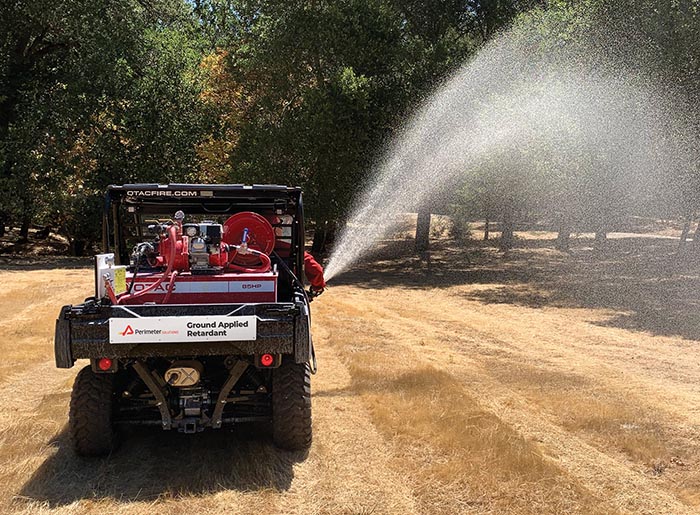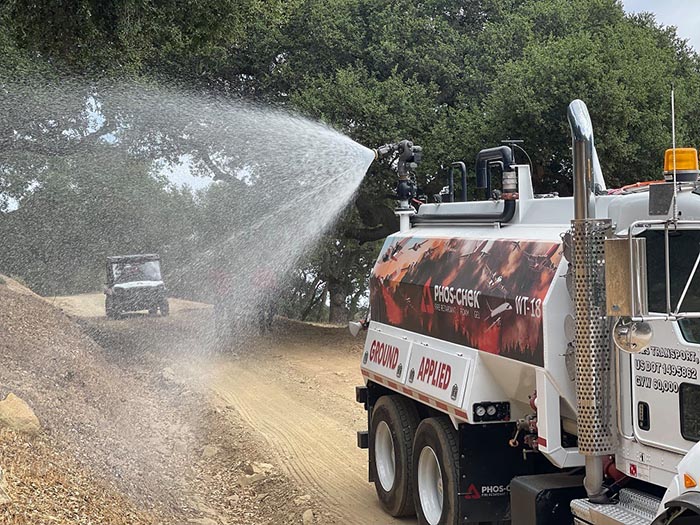
The US Forest Service has given approval to a new formulation of fire retardant specifically designed to be applied from the ground. Perimeter Solutions, the maker of PHOS-CHEK long term fire retardant, has added PHOS-CHEK FORTIFY to its inventory of products, saying that “it is the only highly-durable fire retardant that has been approved by USDA Forest Service for preventative application on U.S. federal lands.”
FORTIFY is based on a hydrogel platform and polymer technology to provide enhanced durability to weathering as well as adherence to vegetation. It can be applied on flammable vegetation and cellulosic material early in the fire season before a wildfire approaches and provides ongoing protection, remaining effective until a significant rain event of one inch or more. Unlike retardant dropped from aircraft, which is colored to help pilots track where the retardant is dropped during active wildfires, the durable FORTIFY fire retardant is uncolored and is precision applied from the ground.
Perimeter Solutions says the product was developed in 2018 and over the past three years utilities, railroads, insurance companies, homeowners, and other industries have adopted it as a solution to prevent wildfire ignitions and proactively protect their property from wildfires.


It’s important to read the SDS before believing what the MFG states in a media release. How about an environmentally green product that’s truly organic? Here is a product that is getting a lot of attention. Take a look. https://www.teamfti.com/greenfire
This is horrible. Very little consultations has been given to how this effects the plants, insects, birds and right on up the food chain. Who cares if it burns if it’s dead already?
It would be interesting to see which fire managers own stock in Phos Check. I’ve seen millions of dollars of their products wasted in unthinkable ways.
Ben, I’d be curious too. When I worked in R8 FS I was surprised to find out that the man who bought the dozers, bought them from his brother-in-law. Both got huge kick backs.
At least it is another tool in the box. Not cheap, not a “one size fits all” but another tool. And a way to get retardant on the ground when conditions prevent aircraft from flying. Cost depends on the topography and ranges from $7,000 to $15,000 per mile (1.6 kilometers) covering a 20-foot (6-meter) -wide strip according to an article in SFGate. https://www.sfgate.com/news/article/Fire-retardant-could-be-game-changer-in-16510604.phpUS?utm_campaign=socialflow&utm_source=facebook.com&utm_medium=referral&fbclid=IwAR3DVfH6H9aw1fRy8qPzOgkcEE-QfUsjVhdCWKLJASKVVaRHF6UZpVJ6-WA
I can’t believe this…Why are they spraying this…they know that this stuff causes cancer?
Can you back up that statement? We strive for the truth here.
Yes. I can. Retardants have PFAs in them which are HAPs and are toxic. The FS needs a Title V permit to spray this stuff. They knew they would not get approval by the state to spray this, so they didn’t even apply for a Title V permit. This is a violation of the law and the FS should be heavy fined.
Are you familiar with the formulation of this new product?
Yes
@SR: Can you link safety data sheet showing inclusion of PFAs in this product? I’ve found nothing after a thorough search. This would be a departure from all their other products.
https://www.pushkin.fm/episode/wildfire-ignition-is-solvable/
made of cellulose + colloidal silica
??
This product is on the shelf at Home Depot, has been for a couple years. $60 a gallon. Seriously.
Marketed to homeowners As though it’s an option that would allow them to skip creating defensible space and maintaining their landscape.
I’d be reluctant to spray plants without first learning more, but I wonder how well this works on wood fences?
Im interested in how it affects animals, nervy crops, and bodies of water.
As well as humans who might hike through a treated area.
Why not properly manage our forests rather than burn them up?
Nothing beats removing flammable fuel and maintaining a defensible space.
My thoughts exactly. The photos show them applying it to bare soil and rocks. . .
I would love to see some studies or evidence of this being used as pre-treatment prior to prescribed fire operations showing its effectiveness with timelines showing varying length of time from application to fire contact and intensity. First I have heard of this product but seems along the lines of other “water enhancers” that are being used but possibly a more durable product.
Back in the 80s Phos-Chek marketed their L-T retardant for ground-based applications. Monsanto tested this product extensively at NWRs in the California Central Valley for rx burning in upland fuel types (FBFM 1 & 3). However you could not “batch-mix it” in a single tank like on a Type 6 engine. Western Fire Equipment Company then developed and marketed a 250 gallon slip-on tank with 18 hp pump that mixed the L-T retardant in separate chambers. This resolved the “batch-mixing” issue. Class A Foam and Compressed Air Foam Systems were just being being developed and took attention and momentum away from the ground applied L-T retardant and the product withered away.
I had the opportunity in the mid-90s to talk with Astaris (who bought out Phos-Chek from Monsanto) and sold me on the concept of applying L-T retardant from a slip-on for rx burning. I had Cascade Fire Equipment Company in Oregon build one of those duo chamber slip-on units. We used the L-T retardant as a pre-treatment on lighter fuels so we wouldn’t have to keep an engine patrolling the line on “quieter” sides of the rx perimeter.
I think it worked great and allowed us to “cut loose” engines and personnel for more active flanks of the rx unit.
We’d apply it up to 7 days prior to ignition. As long as we didn’t get any rain or extensive fog on the retardant treated fuels it worked fine.